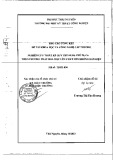
Characterization of a
Saccharomyces cerevisiae
NADP(H)-dependent
alcohol dehydrogenase (ADHVII), a member of the cinnamyl alcohol
dehydrogenase family
Carol Larroy, Xavier Pare
´s and Josep A. Biosca
Department of Biochemistry and Molecular Biology, Universitat Auto
`noma de Barcelona, Barcelona, Spain
A new NADP(H)-dependent alcohol dehydrogenase (the
YCR105W gene product, ADHVII) has been identified in
Saccharomyces cerevisiae. The enzyme has been purified to
homogeneity and found to be a homodimer of 40 kDa
subunits and a pI of 6.2–6.4. ADHVII shows a broad sub-
strate specificity similar to the recently characterized
ADHVI (64% identity), although they show some differ-
ences in kinetic properties. ADHVI and ADHVII are the
only members of the cinnamyl alcohol dehydrogenase family
in yeast. Simultaneous deletion of ADH6 and ADH7 was not
lethal for the yeast. Both enzymes could participate in the
synthesis of fusel alcohols, ligninolysis and NADP(H)
homeostasis.
Keywords: cinnamyl alcohol dehydrogenase; fusel alcohols;
NADP(H) homeostasis; ligninolysis.
The current version of the Yeast Proteome Database
(http://www.proteome.com) lists approximately 260 oxido-
reductases (160 of them have been characterized
experimentally, and the rest predicted by sequence
similarity or by other analysis) [1]. Our group is
interested in the identification and characterization of
novel alcohol dehydrogenase (ADH) gene products from
Saccharomyces cerevisiae [2,3]. ADHs are oxidoreductases
that catalyze the reversible oxidation of alcohols to
aldehydes or ketones, with the corresponding reduction
of NAD or NADP. ADHs constitute a large group of
enzymes that can be subdivided into at least three distinct
enzyme superfamilies: medium-chain and short-chain
dehydrogenases/reductases, and iron-activated alcohol
dehydrogenases [4,5]. The medium-chain dehydrogenase/
reductase (MDR) superfamily consists of enzymes with a
subunit size of approximately 350 residues, dimeric or
tetrameric, with two domains in each subunit: one
catalytic and one responsible for the binding of the
nucleotide (NAD or NADP). Many enzymes of the
MDR family have zinc in their active site, and have a
sequence motif known as the zinc-containing ADH
signature: GHEX
2
GX
5
(G,A)X
2
(I,V,A,C,S) [6]. According
to the Pfam and COG databases [7,8], the S. cerevisiae
genome codes for 21 potential MDR enzymes, with 12 of
them showing the zinc ADH signature described above.
These 12 zinc-containing yeast MDR include ADH1,
ADH2,ADH3,ADH5,ADH6,SFA1,SOR1 and its
99% identical YDL246C,XYL2,BDH1,YAL061W and
YCR105W. All these yeast MDRs, except YCR105W
and YAL061W, have enzymatic activities experimentally
determined. In the present study, we report the charac-
terization of the YCR105W gene from S. cerevisiae as a
new alcohol dehydrogenase. The gene was overexpressed
in yeast cells and the corresponding protein product
purified to homogeneity. The enzyme showed a wide
substrate specificity, using NADP(H) as coenzyme. Given
the similar substrate specificities and the sequence identity
(64%) between the Ycr105p and the recently character-
ized ADHVI [3], we propose the name of ADH7,forthe
YCR105W gene and ADHVII for its coded protein. A
null adh7 yeast strain and a double mutant adh6Dadh7D
were constructed and their growths compared with a
wild-type strain.
MATERIALS AND METHODS
Yeast and bacterial strains and plasmids
For cloning procedures we used the Escherichia coli XL1-
Blue strain from Stratagene (Amsterdam, the Netherlands).
The S. cerevisiae yeast strain S288C [9] was used to amplify
the YCR105W gene by PCR. The protease deficient yeast
BJ5459 (MATa, ura3–52,trp1,lys2-801,leu2D1,his3D200,
pep4::HIS3, prb1D1.6R,can1 GAL) [10] was used to purify
Ycr105p (ADHVII). The yeast strains BJ2168 (MATa, leu2,
trp1,ura3–52,prb1-1122,prc1-407,pep4-3,gal2) [10] and
BJ18 (MATa, leu2,trp1,ura3–52,adh6::TRP1,prb1-1122,
prc1-407,pep4-3,gal2) [3] were used to delete the YCR105W
gene.
The galactose-inducible E. coli yeast shuttle vector pYes2
(carrying the selective URA3 marker and the upstream
activating and promoter sequences of GAL1) purchased
from Invitrogen (Groningen, the Netherlands) was used to
clone and overexpress the YCR105W gene in the yeast
strain BJ5459. E. coli was grown at 37 CinLBmedium
Correspondence to J. A. Biosca, Department of Biochemistry and
Molecular Biology, Faculty of Sciences, Universitat Auto
`noma
de Barcelona, E-08193 Bellaterra (Barcelona), Spain.
Fax: + 34 93 5811264, Tel.: + 34 93 5813070,
E-mail: josep.biosca@uab.es
Abbreviations: ADH, alcohol dehydrogenase; MDR, medium-chain
dehydrogenase/reductase; YPD, a rich medium (yeast extract,
peptone and dextrose) used to grow yeast.
(Received 29 July 2002, revised 1 October 2002,
accepted 7 October 2002)
Eur. J. Biochem. 269, 5738–5745 (2002) FEBS 2002 doi:10.1046/j.1432-1033.2002.03296.x






























